Your guitar is pretty useless if you don’t know how to tune it. In this guide, we look at how to tune an electric guitar, with a simple guide that you can follow. There are a few different ways that you can use to tune your guitar. Some people opt for a digital tuner, some people are even brilliant at tuning their guitar by ear. However, it will probably take you some time to reach the stage where you are good at doing this, so we recommend using a tuner to get you started.
Tuning isn’t the most glamorous aspect of learning how to play the guitar, but it is something that every guitarist needs to be able to do. Luckily, with electric guitars, it is a bit easier than acoustic guitars, and the skill only takes a few minutes for most to master, not like some other electric guitar skills that can take years!
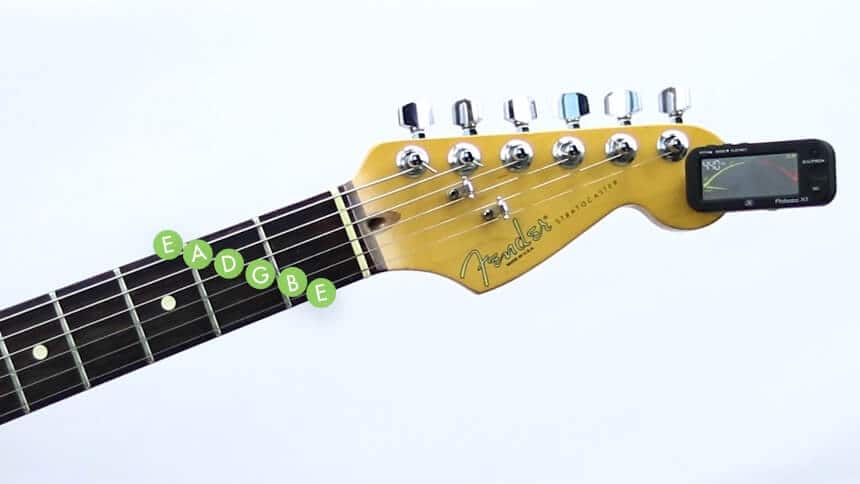 Guitars can be tuned in a variety of different ways, but you don’t need to worry about this to get started. There is one “standard” tuning for the guitar. E-A-D-G-B-E. Most mainstream songs that you hear make use of this tuning. If you listen to a pop song, for example, it’s likely that it was written in standard tuning.
Guitars can be tuned in a variety of different ways, but you don’t need to worry about this to get started. There is one “standard” tuning for the guitar. E-A-D-G-B-E. Most mainstream songs that you hear make use of this tuning. If you listen to a pop song, for example, it’s likely that it was written in standard tuning.
To make it easier to remember this, there are a few simple phrases. They feel a little bit childish and are great for teaching kids, but they’re actually really effective. As an adult, they will probably make it much easier to remember.
Another really common phrase is “Eddie Ate Dynamite Good Bye Eddie”. Okay, it’s a little bit insensitive, but it certainly is memorable!
Why is this important? Well, you might only have a piano to tune from. If you need to tune an electric guitar without a tuner, you need to know which of the strings is which when you generate the tone on a piano.
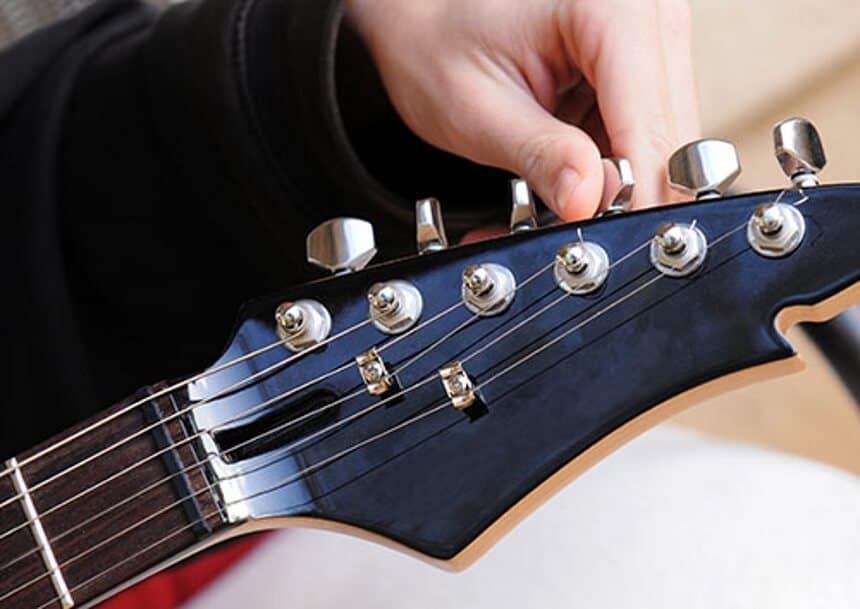 If you are brand new to the guitar, there is no shame in not knowing how to tune it. If you are looking into how to tune an electric guitar for beginners, you might not even understand the very basics of tuning; the tuning pegs.
If you are brand new to the guitar, there is no shame in not knowing how to tune it. If you are looking into how to tune an electric guitar for beginners, you might not even understand the very basics of tuning; the tuning pegs.
On the headstock of your guitar, there are six tuning pegs, which tighten or loosen the strings. This is how you affect the tune. If it is “flat” then you need to tighten it. If it is “sharp” then you need to loosen it. When you are tuning then all you need to do is alter the length of the strings, and the tune will change.
While you are fiddling with the tuning pegs, you also need to keep playing the string. Periodically pluck the string using your finger or a plectrum to make sure it keeps generating a tone, otherwise, your tuner won’t have anything to react to!
Remember, one string at a time. Otherwise, the tuner will try and pick up the sound of all six and it will quickly become very messy.
Most modern instruments use the chromatic scale. This means using semi-tones as the measure on the scale. Chromatic tuners tune related to the nearest semitone on the scale.
Chromatic
Trusted Source
Diatonic and chromatic - Wikipedia
Diatonic and chromatic are terms in music theory that are most often used to characterize scales and are also applied to musical instruments, intervals, chords, notes, musical styles, and kinds of harmony. They are very often used as a pair, especially when applied to contrasting features of the common practice music of the period 1600–1900.
en.wikipedia.org
tuners can be used to tune instruments other than guitars and also to change the tuning of your guitar, to make use of alternate tunings.
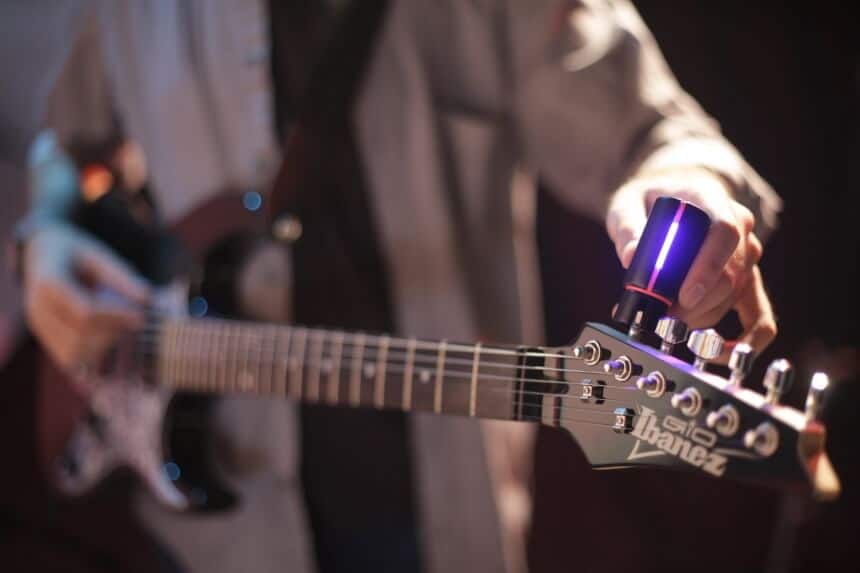 It is easy to tune a guitar with an electric tuner…once you know how!
It is easy to tune a guitar with an electric tuner…once you know how!
The tuner will have some sort of display. This shows you which note you are closest to while you are tuning. It also shows whether you are sharp or flat. A dial shows up, much like the speedometer dial in a car. If you are a bit flat, it will show to the left of the center. If you are sharp, the dial goes to the right when you are playing the string. You will need to adjust the strings accordingly.
Using an electronic tuner can be done in a few different ways. They have a microphone inbuilt and can use this to pick up the sound and tell you how you need to adjust.
If you are going to use the microphone inside the tuner, you need to:
The more reliable method to tune an electric guitar (one which isn’t an option with an acoustic guitar) is to connect to your tuner using a jack cable. Most tuners have a line input. This means you can connect the guitar to the tuner just like you would connect it to an amp or effects pedals.
This way, the tuner can sense the vibrations and give you an accurate reading to start your tuning.
Most new electronic tuners will automatically detect which string you are playing. Always check this is a feature. If not, you might have to adjust the settings of your tuner to tell it which string you are going to pick before you try to tune and repeat this for all 6 strings.
Electric tuners don’t cost much, and might even come in your electric guitar “pack” when you buy a beginner bundle. If they use batteries you can even use them on the go, before a gig.
A lot of tuners in this style also clip onto the instrument. This is better for acoustic guitars, as it frees up your hands but relies on the projection of the acoustic guitar. It can still be useful for electric guitars, though.
There are a few different types of tuners, which we will explore below so that you can fully understand how each of them is used.
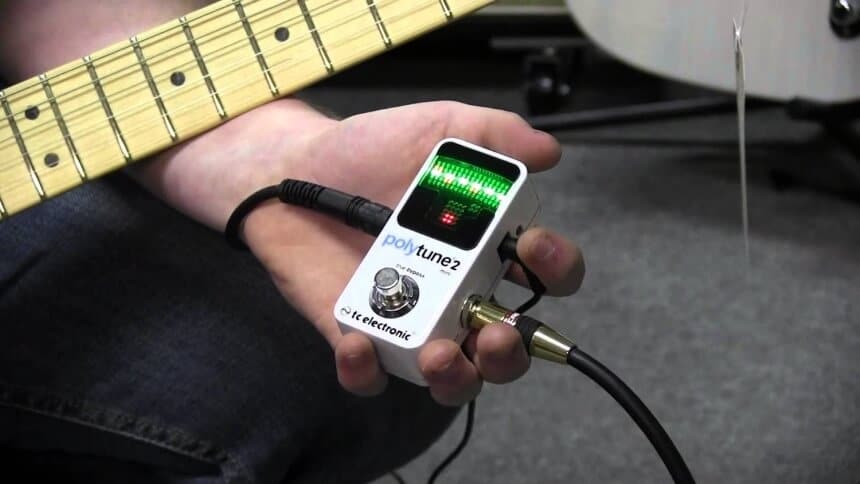 A pedal tuner is exactly what you might think. It fits in your pedalboard and functions like other guitar pedals. You can use it in your pedal chain. We recommend putting it first in the chain because tuning is vital, and the other effects pedals might mess with the tuning.
A pedal tuner is exactly what you might think. It fits in your pedalboard and functions like other guitar pedals. You can use it in your pedal chain. We recommend putting it first in the chain because tuning is vital, and the other effects pedals might mess with the tuning.
A pedal tuner allows you to use both of your hands freely, perfect for tweaking your tuning pegs.
If you’ve ever been at a gig and in between songs you see a guitarist tweaking their guitar tuners while staring down, they’re looking at a pedal.
Another reason why you really need to use a pedal tuner if you are playing in a band on stage is the fact that other instruments are on stage, so you need to be able to plug your instrument in via the jack lead, not rely on the inbuilt microphone. Other sounds will inevitably interfere with the sound.
You can check out our top pick for a pedal tuner, which has a simple LED meter, which is very bright, allowing you to tune in the dark with ease. Lots of gigs are very dark, and this might be a super useful feature.
One downside of pedal tuners is the fact that they require power, usually not from a battery but from a mains power supply. This is fine for gigs and practices, but they’re not the most portable. Also, they cost a little more than some of the other types of tuners.
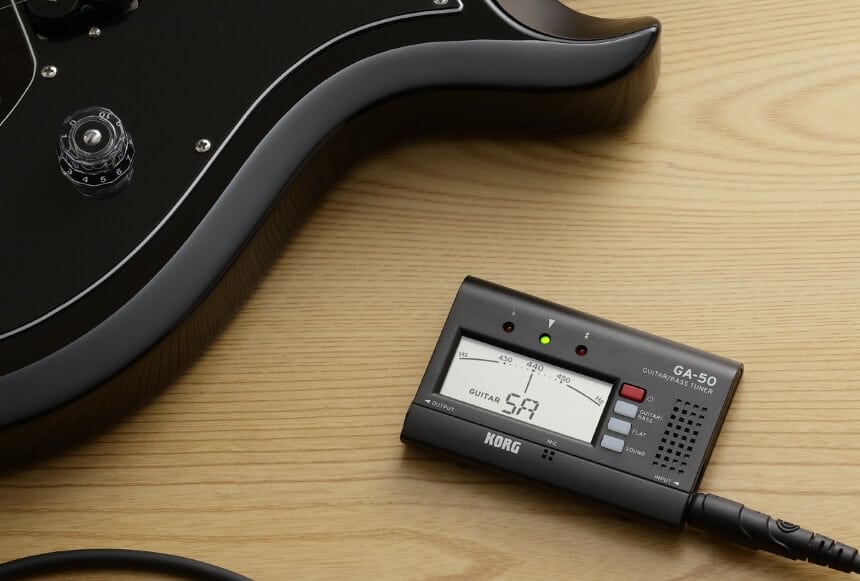 A handheld tuner is likely to be a much cheaper method of tuning your electric guitar. Handheld tuners are a good option if you have to tune lots of different instruments. A lot of these tuners give you the option to tune in different pitches and are suited to a variety of instruments. You can tune a ukulele, a bass, or an electric guitar just as easily.
A handheld tuner is likely to be a much cheaper method of tuning your electric guitar. Handheld tuners are a good option if you have to tune lots of different instruments. A lot of these tuners give you the option to tune in different pitches and are suited to a variety of instruments. You can tune a ukulele, a bass, or an electric guitar just as easily.
If you’re going to use a handheld tuner as your main tuning method then you will probably need to sit down and have it on your lap, this will free up your hands to do the actual tuning of the instrument.
Handheld tuners are cheap, convenient, and portable. They’re a great method of tuning an electric guitar, especially if they have the option to plug your guitar in to get a more reliable read. Most of them operate on batteries so that you can use them anywhere.
A good solution for a lot of beginners is to use a mobile tuner app. Because most of us carry around a device in our pockets that are equipped with a decent quality microphone, a mobile tuner app might be a perfect solution.
Mobile tuners use this microphone to pick up the pitch of your instrument and work in the exact same way as a handheld tuner or clip-on tuner. The meter shows you whether you are sharp or flat, and you adjust the tuning peg until the meter is right in the middle.
You can download a lot of mobile tuner apps for free, but beware, many will ask you to pay in the future, especially if you want to access the other tunings that they offer. This “freemium” business model is really popular among apps.
A mobile tuner app is convenient because your phone is likely to always be on you. It’s a good idea to have one, but it shouldn’t be your only method of tuning your guitar. If you want to tune reliably then a mobile tuner will be best. What’s more, you have to rely on the microphone in your phone which might not be reliable. On top of that, you might get a call, or a bandmate might strike up and start playing while you’re trying to tune. It’s a good way to tune a guitar for beginners, but it isn’t the most professional method for the long term.
A rackmount tuner is a more expensive option, and only works if you have an effects rack.
These racks are great for gigs. If you’re a touring musician then a rack can include an EQ, tuner and a load of other effects that your sound technician can control.
Rackmount tuners work in the same way as the others, but rely on an audio signal coming from the guitar itself, or routed from a mixing desk. It’s a more complex way of tuning an electric guitar, and it is more expensive, but rackmount tuners are great for tuning up the whole band.
If you’ve ever seen a guitarist tune totally by ear, it’s really quite impressive. If you get to the stage where you can do this then you might think you can always tune up just by using your own senses!
This isn’t the most reliable method of tuning. But it is good to learn.
Learning how to tune by ear is a way to help with your pitch training and learning more about your instrument, so it is good to have a rough idea of the pitch. Tuning by ear might be good if you are practicing on your own but it is easy to get it slightly wrong and end up out of tune with the other musicians in your band.
Tuning by ear takes time. You need to familiarize yourself with how each of the strings should sound when it is played. To be really good at this, you need a good sense of pitch, and some people never get to this level of ability, even if they are great guitarists.
You can use relative tuning. This is the process of using one string to tune the next.
The 6th string, or the one closest to you as you are playing, needs to be in tune. You can play this string at the fifth fret, and this will give you the tone that the 5th string (next one down) should be. Tune the 5th string accordingly.
You can repeat this for the next two strings, using the fifth fret as your pitch marker. However, when you reach the 3rd string, you need to switch to the fourth fret to give you the correct pitch. The first string, you will go back to the fifth fret.
If you are still confused, there are many videos you can use to help you with relative tuning. Unfortunately, you need to still have one string that is your reference point, that you know is in tune.
There are many different tunings that guitarists should know. They can open up new tonal possibilities for your playing.
Drop D – this relies on you tuning the 6th string “E” down to “D” for a deeper sound. It’s popular for rock and metal styles.
Double Drop D – you tune both of the E strings down to D. This means three of the strings are tuned to D and give a drone-style tone.
DADGAD – this is used a lot for fingerstyle guitar. It is the same as double drop-D except for the fact that the B string has been lowered to an A. This can give a bluesy vibe.
Open G – lots of Rolling Stones and Led Zeppelin songs were written in this tuning. It gives a rock/blues vibe and a lot of the open strings sound good when played together. It’s called open G because you are effectively playing a G when you strum all of the strings.
Open D, open A, and open E are all similar types of tuning where you can play a lot of the strings and they sound good together without any fretting. They’re also good for slide guitar methods.
Once you delve into certain genres of music such as blues, or methods like slide guitar, you can find that there are loads of different tunings used on a regular basis to give a signature sound.
If you find a song that you want to learn and it has an unusual tuning, don’t be scared of it. It is great to know a few different tunings. Even if you’ve just bought your first beginner guitar and you want to better understand the tunings, experiment with a couple of the above. The drop-D tuning is the easiest.
The remaining B and E strings need to be tuned to the same frequency (not an octave apart). They effectively sound almost identical, which makes tuning easier.
Though knowing how to tune a 12-string electric guitar can sound confusing, it’s not actually too difficult, and you can use the other strings as a reference point. They are all tuned relative to one another. 12-string electric guitars aren’t that common. However, it is useful to know that this is an option. 12-string acoustic guitars can be tuned in exactly the same way, with the same gaps between the octaves.
It doesn’t matter how many hours you spend practicing your favorite songs, if your guitar isn’t properly tuned then it is simply not going to sound good. So, it is vital that you learn how to tune an electric guitar.
Electric guitars are a different prospect to acoustic because acoustic guitars do not have the same need to be amplified, or connected via a jack output, to detect the pitch reliably. It doesn’t take too long to get good at tuning, but it is a skill you really need to take the time to learn if you are going to take music seriously. Make sure you’re always pitch-perfect before you rock out.